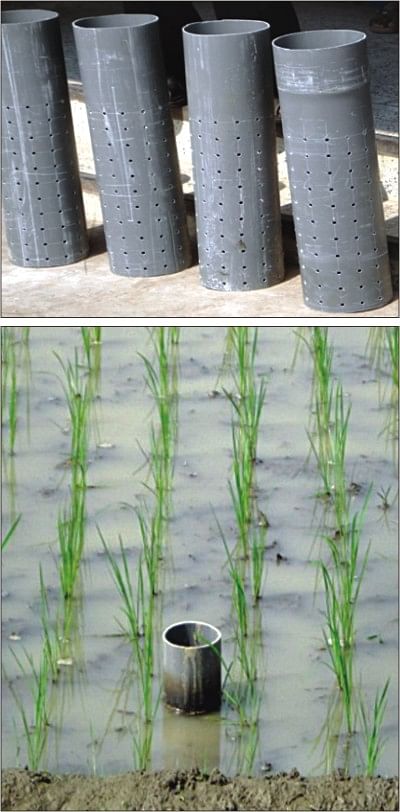<i>'Magic pipe' method produces more rice, saves money, water</i>

Perforated PVC pipes, top, are installed in paddy field after ten days of transplanting seedlings with perforated portion under the surface. Then earth is scooped out of the pipes. Irrigation starts when water level below the surface reaches the bottom of the pipes. Photo: BRRI
Rice scientists have developed a technology called “Alternate Wetting and Drying” (AWD) that reduces production cost by 25 percent but increases production with less irrigation during Boro season.
The technology that has already been validated in the last two to three years can help maintain the balance of underground water, which is depleting fast due to excessive use during dry season, rice scientists said yesterday at a press briefing at BRAC Centre Inn in the capital.
International Rice Research Institute (IRRI), Bangladesh Rice Research Institute (BRRI) and Rural Development Academy (RDA) devised and experimented the method.
“Only 1,500 litres of water is enough to grow a kilogram of rice where farmers in Bangladesh apply 3,000 to 5,000 litres wasting much water and fuel,” said TP Toung, senior scientist of IRRI in Bangladesh.
The technology is very simple, he said, adding that this requires only a plastic pipe, a hollow bamboo or a plastic water bottle measuring 30cm long and 10cm in diameter. Two-thirds of the pipe or bottle should be perforated.
After ten days of transplanting boro seedlings to field the pipe should be installed in the field with its perforated part under the surface. The earth inside the pipe then should be scooped out, Toung explained to the press.
He continued, “Now wait and see till the water level goes down below the surface and reaches the bottom of the pipe or bottle. When it does, the farmers should prepare for irrigation.”
Generally, farmers keep their fields stagnant with water thinking it helps boost production, said the rice scientist, adding that this orthodox idea is actually wrong.
The AWD method, also known as “Magic Pipe”, makes sure that the plants do not suffer from water crisis though the field may apparently look dry. It saves both water and energy but increases yield.
MA Sattar, head of Irrigation and Water Management Division of BRRI, said paddy plants produce more stems with intermittent dryness in the field.
“But, farmers must discontinue AWD process when paddy flowers. Water must be stagnant during flowering,” he said.
Experiments of AWD method in various parts of the country proved that farmers can save 29 percent water and at the same time rice production can increase by 0.35 to 0.80 tonnes per hectare. “Altogether, a farmer can save 25 percent of his production cost,” Sattar said.
BRAC Executive Director Mahabub Hossain said AWD is a revolutionary technology that can help reduce the price of the country's staple food. The government should extensively introduce and popularise the technology, he stressed.
IRRI Liaison Scientist for Bangladesh MA Hamid Miah and BRRI Director General Firoz Shah Sikder also spoke at the briefing.

 For all latest news, follow The Daily Star's Google News channel.
For all latest news, follow The Daily Star's Google News channel. 



Comments